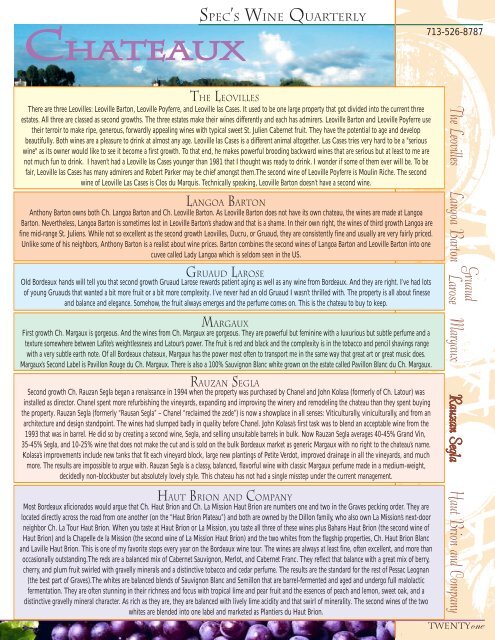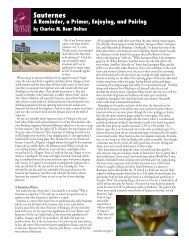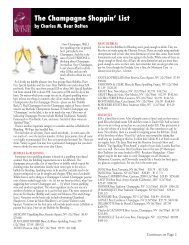What I Tasted on My Spring Break - SPEC's Liquors
What I Tasted on My Spring Break - SPEC's Liquors
What I Tasted on My Spring Break - SPEC's Liquors
You also want an ePaper? Increase the reach of your titles
YUMPU automatically turns print PDFs into web optimized ePapers that Google loves.
713-526-8787<br />
There are three Leovilles: Leoville Bart<strong>on</strong>, Leoville Poyferre, and Leoville las Cases. It used to be <strong>on</strong>e large property that got divided into the current three<br />
estates. All three are classed as sec<strong>on</strong>d growths. The three estates make their wines differently and each has admirers. Leoville Bart<strong>on</strong> and Leoville Poyferre use<br />
their terroir to make ripe, generous, forwardly appealing wines with typical sweet St. Julien Cabernet fruit. They have the potential to age and develop<br />
beautifully. Both wines are a pleasure to drink at almost any age. Leoville las Cases is a different animal altogether. Las Cases tries very hard to be a "serious<br />
wine" as its owner would like to see it become a first growth. To that end, he makes powerful brooding backward wines that are serious but at least to me are<br />
not much fun to drink. I haven’t had a Leoville las Cases younger than 1981 that I thought was ready to drink. I w<strong>on</strong>der if some of them ever will be. To be<br />
fair, Leoville las Cases has many admirers and Robert Parker may be chief am<strong>on</strong>gst them.The sec<strong>on</strong>d wine of Leoville Poyferre is Moulin Riche. The sec<strong>on</strong>d<br />
wine of Leoville Las Cases is Clos du Marquis. Technically speaking, Leoville Bart<strong>on</strong> doesn’t have a sec<strong>on</strong>d wine.<br />
Anth<strong>on</strong>y Bart<strong>on</strong> owns both Ch. Langoa Bart<strong>on</strong> and Ch. Leoville Bart<strong>on</strong>. As Leoville Bart<strong>on</strong> does not have its own chateau, the wines are made at Langoa<br />
Bart<strong>on</strong>. Nevertheless, Langoa Bart<strong>on</strong> is sometimes lost in Leoville Bart<strong>on</strong>’s shadow and that is a shame. In their own right, the wines of third growth Langoa are<br />
fine mid-range St. Juliens. While not so excellent as the sec<strong>on</strong>d growth Leovilles, Ducru, or Gruaud, they are c<strong>on</strong>sistently fine and usually are very fairly priced.<br />
Unlike some of his neighbors, Anth<strong>on</strong>y Bart<strong>on</strong> is a realist about wine prices. Bart<strong>on</strong> combines the sec<strong>on</strong>d wines of Langoa Bart<strong>on</strong> and Leoville Bart<strong>on</strong> into <strong>on</strong>e<br />
cuvee called Lady Langoa which is seldom seen in the US.<br />
Old Bordeaux hands will tell you that sec<strong>on</strong>d growth Gruaud Larose rewards patient aging as well as any wine from Bordeaux. And they are right. I’ve had lots<br />
of young Gruauds that wanted a bit more fruit or a bit more complexity. I’ve never had an old Gruaud I wasn’t thrilled with. The property is all about finesse<br />
and balance and elegance. Somehow, the fruit always emerges and the perfume comes <strong>on</strong>. This is the chateau to buy to keep.<br />
First growth Ch. Margaux is gorgeous. And the wines from Ch. Margaux are gorgeous. They are powerful but feminine with a luxurious but subtle perfume and a<br />
texture somewhere between Lafite’s weightlessness and Latour’s power. The fruit is red and black and the complexity is in the tobacco and pencil shavings range<br />
with a very subtle earth note. Of all Bordeaux chateaux, Margaux has the power most often to transport me in the same way that great art or great music does.<br />
Margaux’s Sec<strong>on</strong>d Label is Pavill<strong>on</strong> Rouge du Ch. Margaux. There is also a 100% Sauvign<strong>on</strong> Blanc white grown <strong>on</strong> the estate called Pavill<strong>on</strong> Blanc du Ch. Margaux.<br />
Sec<strong>on</strong>d growth Ch. Rauzan Segla began a renaissance in 1994 when the property was purchased by Chanel and John Kolasa (formerly of Ch. Latour) was<br />
installed as director. Chanel spent more refurbishing the vineyards, expanding and improving the winery and remodeling the chateau than they spent buying<br />
the property. Rauzan Segla (formerly “Rausan Segla” – Chanel “reclaimed the zede”) is now a showplace in all senses: Viticulturally, viniculturally, and from an<br />
architecture and design standpoint. The wines had slumped badly in quality before Chanel. John Kolasa’s first task was to blend an acceptable wine from the<br />
1993 that was in barrel. He did so by creating a sec<strong>on</strong>d wine, Segla, and selling unsuitable barrels in bulk. Now Rauzan Segla averages 40-45% Grand Vin,<br />
35-45% Segla, and 10-25% wine that does not make the cut and is sold <strong>on</strong> the bulk Bordeaux market as generic Margaux with no right to the chateau’s name.<br />
Kolasa’s improvements include new tanks that fit each vineyard block, large new plantings of Petite Verdot, improved drainage in all the vineyards, and much<br />
more. The results are impossible to argue with. Rauzan Segla is a classy, balanced, flavorful wine with classic Margaux perfume made in a medium-weight,<br />
decidedly n<strong>on</strong>-blockbuster but absolutely lovely style. This chateau has not had a single misstep under the current management.<br />
Most Bordeaux afici<strong>on</strong>ados would argue that Ch. Haut Bri<strong>on</strong> and Ch. La Missi<strong>on</strong> Haut Bri<strong>on</strong> are numbers <strong>on</strong>e and two in the Graves pecking order. They are<br />
located directly across the road from <strong>on</strong>e another (<strong>on</strong> the “Haut Bri<strong>on</strong> Plateau”) and both are owned by the Dill<strong>on</strong> family, who also own La Missi<strong>on</strong>’s next-door<br />
neighbor Ch. La Tour Haut Bri<strong>on</strong>. When you taste at Haut Bri<strong>on</strong> or La Missi<strong>on</strong>, you taste all three of these wines plus Bahans Haut Bri<strong>on</strong> (the sec<strong>on</strong>d wine of<br />
Haut Bri<strong>on</strong>) and la Chapelle de la Missi<strong>on</strong> (the sec<strong>on</strong>d wine of La Missi<strong>on</strong> Haut Bri<strong>on</strong>) and the two whites from the flagship properties, Ch. Haut Bri<strong>on</strong> Blanc<br />
and Laville Haut Bri<strong>on</strong>. This is <strong>on</strong>e of my favorite stops every year <strong>on</strong> the Bordeaux wine tour. The wines are always at least fine, often excellent, and more than<br />
occasi<strong>on</strong>ally outstanding.The reds are a balanced mix of Cabernet Sauvign<strong>on</strong>, Merlot, and Cabernet Franc. They reflect that balance with a great mix of berry,<br />
cherry, and plum fruit swirled with gravelly minerals and a distinctive tobacco and cedar perfume. The results are the standard for the rest of Pessac Leognan<br />
(the best part of Graves).The whites are balanced blends of Sauvign<strong>on</strong> Blanc and Semill<strong>on</strong> that are barrel-fermented and aged and undergo full malolactic<br />
fermentati<strong>on</strong>. They are often stunning in their richness and focus with tropical lime and pear fruit and the essences of peach and lem<strong>on</strong>, sweet oak, and a<br />
distinctive gravelly mineral character. As rich as they are, they are balanced with lively lime acidity and that swirl of minerality. The sec<strong>on</strong>d wines of the two<br />
whites are blended into <strong>on</strong>e label and marketed as Plantiers du Haut Bri<strong>on</strong>.





